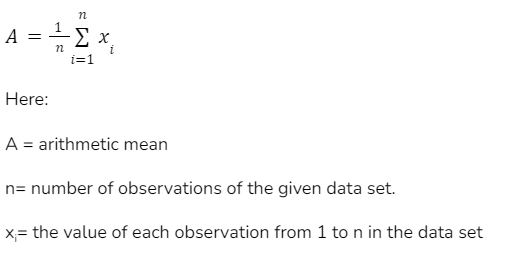The arithmetic mean is the oldest method used to combine observations to conclude a unique approximate value. It is said that a Babylonian astronomer first used it in the third century. He used arithmetic means to determine the positions of the sun, the moon and the other planets. As per Plackett in 1958, the arithmetic means concept originated from the Greek astronomer Hipparchus. Thomas Simpson officially proposed the idea in 1755.
In mathematics, the arithmetic mean or arithmetic average, or simply just the mean or the average, is the sum of a collection of all the numbers in a data set divided by the count of numbers in that data set. These data sets are usually obtained by a survey or study of occurrences of any event. The term “arithmetic mean” is preferred because it helps distinguish it from other means, for example, the geometric mean and the harmonic mean.
Meaning of Average Arithmetic Mean
Arithmetic mean is a fancy name for the terms like average, mean of numbers/values.
The arithmetic mean is the arithmetic average in a data set. It is the central value of the given finite(number of observations is limited or countable) set of numbers. The sum of all the values is divided by the number of values in the given finite set.
Example:
The average arithmetic mean of a data set with numbers 4, 6, 7,15 is 8.
Since 4+6+7+15 = 32 and 32 divided by 4 [because there are four numbers] is 8.
Hence the arithmetic mean comes out to be 8.
General Formula To Find the Arithmetic Average Mean

In other words, it means the summation of all the n number of values/observations of the given data set divided by the total number of values of that data set.
We can manipulate this general formula to find the unknowns in different cases, but we need not remember a particular procedure for every case; instead, we can derive it from the general formula itself.
Examples of average arithmetic mean
Example 1 (basic):
The marks of a student in five subjects are 96, 98, 70, 80 and 86. Find the arithmetic average mean of the marks obtained by the student.
Solution:
We have learned that arithmetic mean marks of the student is equal to the sum of the marks in all the subjects divided by the number of subjects.
= (96 + 98 + 70 + 80 + 86 )/5
=430/5
= 86
Example 2 (complex):
The given arithmetic mean of the heights of 6 mannequins in a mall is equal to 152 cm. The height of five mannequins is 149 cm,151 cm, 153 cm, 154 cm and 155 cm; find the height of the sixth mannequin in the mall.
Solution:
We are given the arithmetic mean height of 6 mannequins = 152 cm.
Therefore we can obtain the sum of the heights of 6 mannequins by multiplying the mean arithmetic height of the mannequins by the total number of mannequins.
= (152 × 6) cm
= 912 cm
Now calculating the sum of the heights of 5 mannequins
= (149 + 151 + 153 + 154 155) cm
= 762 cm.
Therefore the height of the sixth mannequin
= sum of the heights of 6 mannequins – the sum of the heights of 5 mannequin
= 912 cm – 762 cm
= 150 cm.
Therefore, the height of the sixth mannequin is 150 cm.
Conclusion
The arithmetic mean is frequently used in many fields such as anthropology, economics, history, etc., and it is also used in almost every academic field as it is used to find a unique approximate value for a data set containing variable values. A survey usually has vast data sets of values; studying every value variation to conclude is difficult. Arithmetic means to help us by giving us an approximate value to make our survey result more feasible.
 Profile
Profile Settings
Settings Refer your friends
Refer your friends Sign out
Sign out






